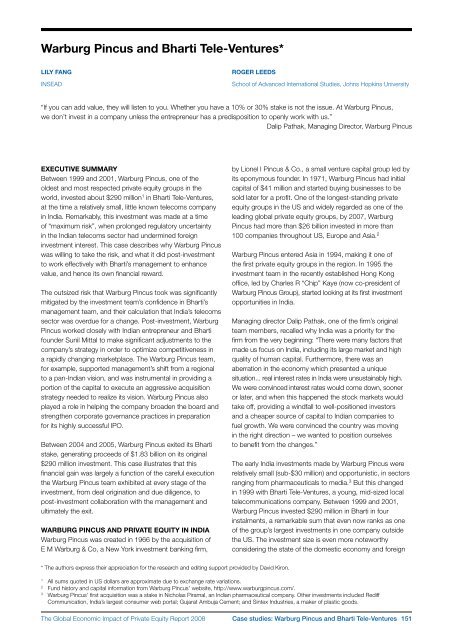The Global Economic Impact of Private Equity Report 2008 - World ...
The Global Economic Impact of Private Equity Report 2008 - World ...
The Global Economic Impact of Private Equity Report 2008 - World ...
- No tags were found...
You also want an ePaper? Increase the reach of your titles
YUMPU automatically turns print PDFs into web optimized ePapers that Google loves.
Warburg Pincus and Bharti Tele‐Ventures*Lily FanginseadRoger LeedsSchool <strong>of</strong> Advanced International Studies, Johns Hopkins University“If you can add value, they will listen to you. Whether you have a 10% or 30% stake is not the issue. At Warburg Pincus,we don’t invest in a company unless the entrepreneur has a predisposition to openly work with us.”Dalip Pathak, Managing Director, Warburg PincusExecutive summaryBetween 1999 and 2001, Warburg Pincus, one <strong>of</strong> theoldest and most respected private equity groups in theworld, invested about $290 million 1 in Bharti Tele‐Ventures,at the time a relatively small, little known telecoms companyin India. Remarkably, this investment was made at a time<strong>of</strong> “maximum risk”, when prolonged regulatory uncertaintyin the Indian telecoms sector had undermined foreigninvestment interest. This case describes why Warburg Pincuswas willing to take the risk, and what it did post‐investmentto work effectively with Bharti’s management to enhancevalue, and hence its own financial reward.<strong>The</strong> outsized risk that Warburg Pincus took was significantlymitigated by the investment team’s confidence in Bharti’smanagement team, and their calculation that India’s telecomssector was overdue for a change. Post‐investment, WarburgPincus worked closely with Indian entrepreneur and Bhartifounder Sunil Mittal to make significant adjustments to thecompany’s strategy in order to optimize competitiveness ina rapidly changing marketplace. <strong>The</strong> Warburg Pincus team,for example, supported management’s shift from a regionalto a pan‐Indian vision, and was instrumental in providing aportion <strong>of</strong> the capital to execute an aggressive acquisitionstrategy needed to realize its vision. Warburg Pincus alsoplayed a role in helping the company broaden the board andstrengthen corporate governance practices in preparationfor its highly successful IPO.Between 2004 and 2005, Warburg Pincus exited its Bhartistake, generating proceeds <strong>of</strong> $1.83 billion on its original$290 million investment. This case illustrates that thisfinancial gain was largely a function <strong>of</strong> the careful executionthe Warburg Pincus team exhibited at every stage <strong>of</strong> theinvestment, from deal origination and due diligence, topost‐investment collaboration with the management andultimately the exit.Warburg Pincus and private equity in IndiaWarburg Pincus was created in 1966 by the acquisition <strong>of</strong>E M Warburg & Co, a New York investment banking firm,by Lionel I Pincus & Co., a small venture capital group led byits eponymous founder. In 1971, Warburg Pincus had initialcapital <strong>of</strong> $41 million and started buying businesses to besold later for a pr<strong>of</strong>it. One <strong>of</strong> the longest‐standing privateequity groups in the US and widely regarded as one <strong>of</strong> theleading global private equity groups, by 2007, WarburgPincus had more than $26 billion invested in more than100 companies throughout US, Europe and Asia. 2Warburg Pincus entered Asia in 1994, making it one <strong>of</strong>the first private equity groups in the region. In 1995 theinvestment team in the recently established Hong Kong<strong>of</strong>fice, led by Charles R “Chip” Kaye (now co‐president <strong>of</strong>Warburg Pincus Group), started looking at its first investmentopportunities in India.Managing director Dalip Pathak, one <strong>of</strong> the firm’s originalteam members, recalled why India was a priority for thefirm from the very beginning: “<strong>The</strong>re were many factors thatmade us focus on India, including its large market and highquality <strong>of</strong> human capital. Furthermore, there was anaberration in the economy which presented a uniquesituation... real interest rates in India were unsustainably high.We were convinced interest rates would come down, sooneror later, and when this happened the stock markets wouldtake <strong>of</strong>f, providing a windfall to well‐positioned investorsand a cheaper source <strong>of</strong> capital to Indian companies t<strong>of</strong>uel growth. We were convinced the country was movingin the right direction – we wanted to position ourselvesto benefit from the changes.”<strong>The</strong> early India investments made by Warburg Pincus wererelatively small (sub‐$30 million) and opportunistic, in sectorsranging from pharmaceuticals to media. 3 But this changedin 1999 with Bharti Tele‐Ventures, a young, mid‐sized localtelecommunications company. Between 1999 and 2001,Warburg Pincus invested $290 million in Bharti in fourinstalments, a remarkable sum that even now ranks as one<strong>of</strong> the group’s largest investments in one company outsidethe US. <strong>The</strong> investment size is even more noteworthyconsidering the state <strong>of</strong> the domestic economy and foreign* <strong>The</strong> authors express their appreciation for the research and editing support provided by David Kiron.1All sums quoted in US dollars are approximate due to exchange rate variations.2Fund history and capital information from Warburg Pincus’ website, http://www.warburgpincus.com/.3Warburg Pincus’ first acquisition was a stake in Nicholas Piramal, an Indian pharmaceutical company. Other investments included RediffCommunication, India’s largest consumer web portal; Gujarat Ambuja Cement; and Sintex Industries, a maker <strong>of</strong> plastic goods.<strong>The</strong> <strong>Global</strong> <strong>Economic</strong> <strong>Impact</strong> <strong>of</strong> <strong>Private</strong> <strong>Equity</strong> <strong>Report</strong> <strong>2008</strong> Case studies: Warburg Pincus and Bharti Tele‐Ventures 151















